实例介绍
【实例截图】
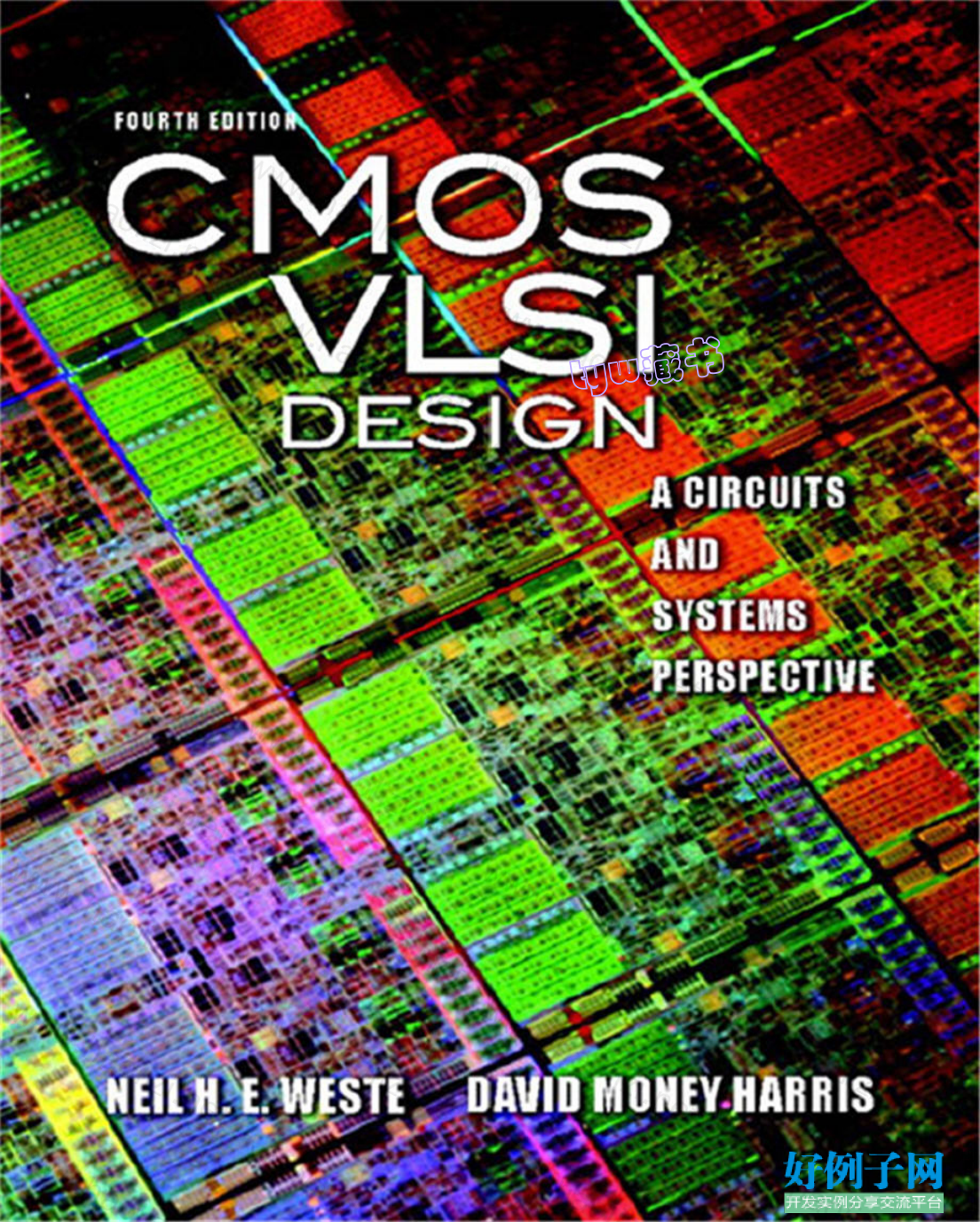
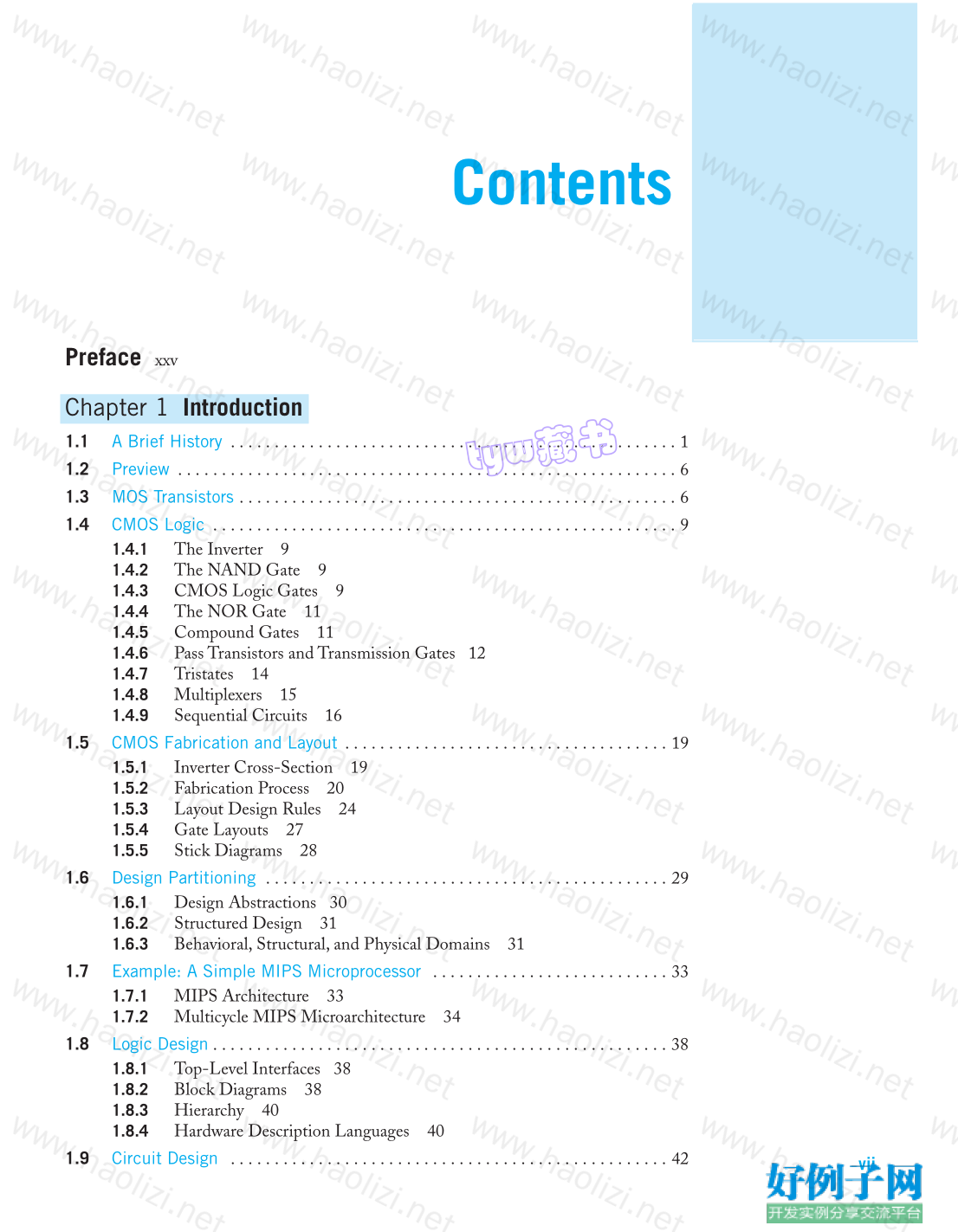

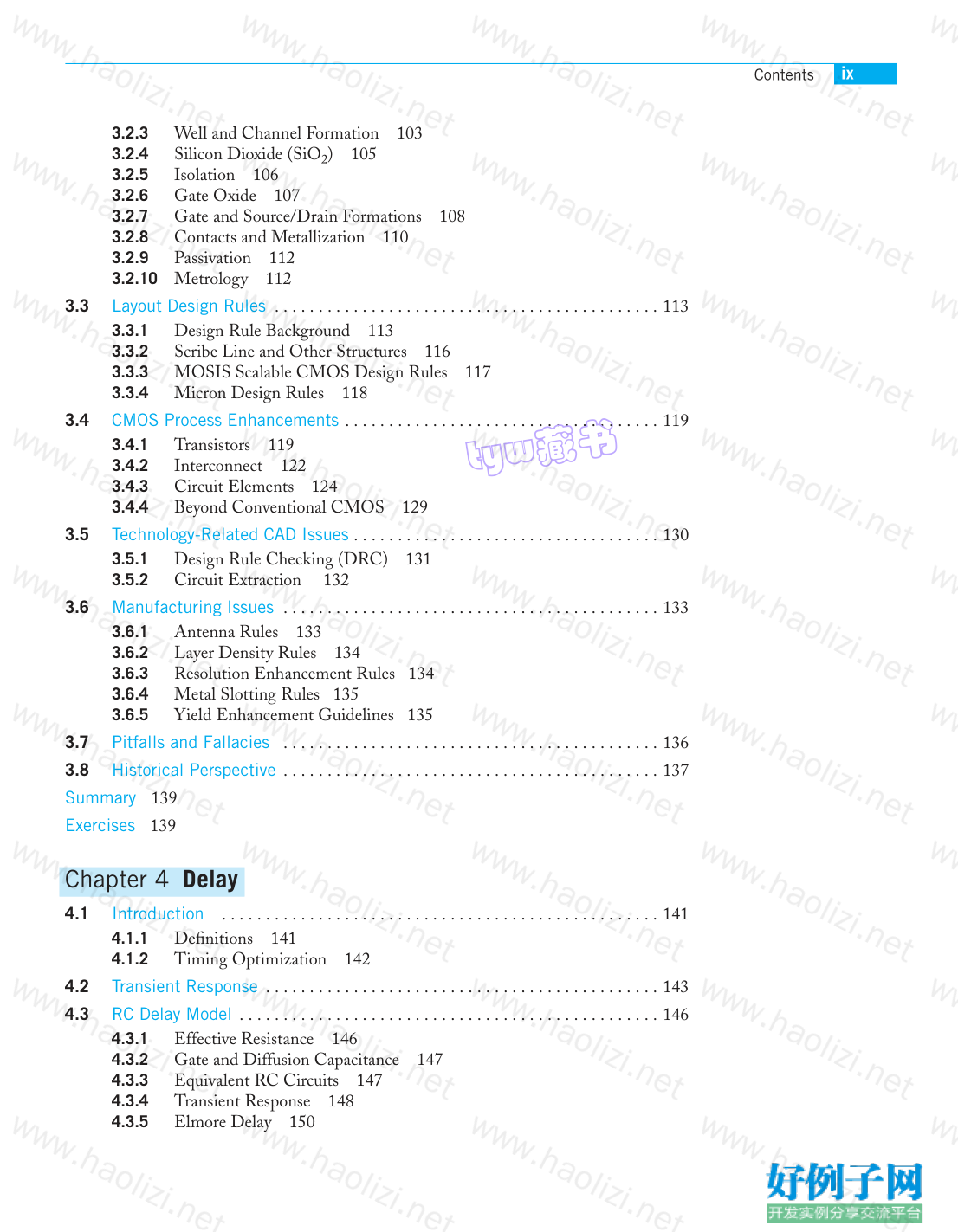
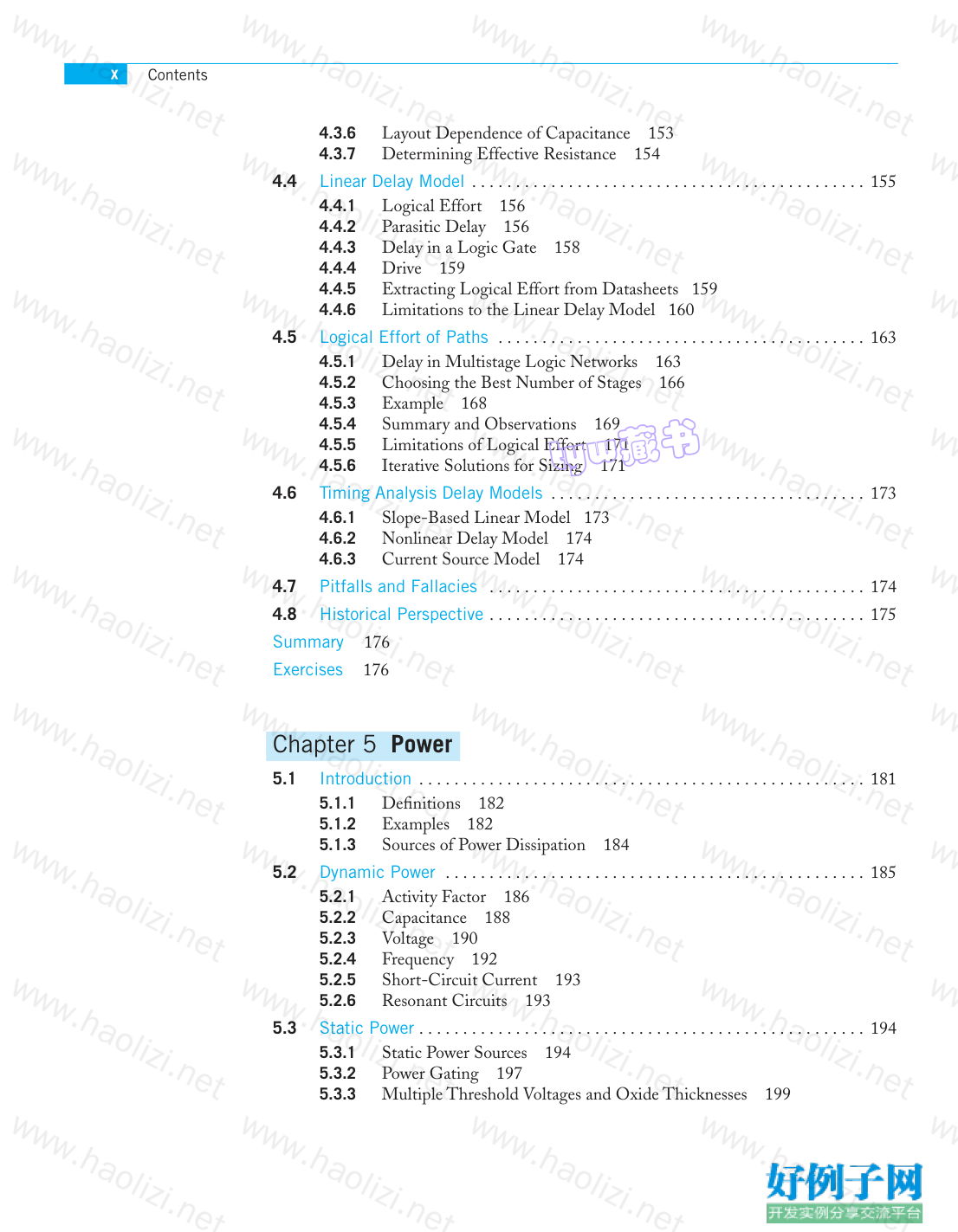

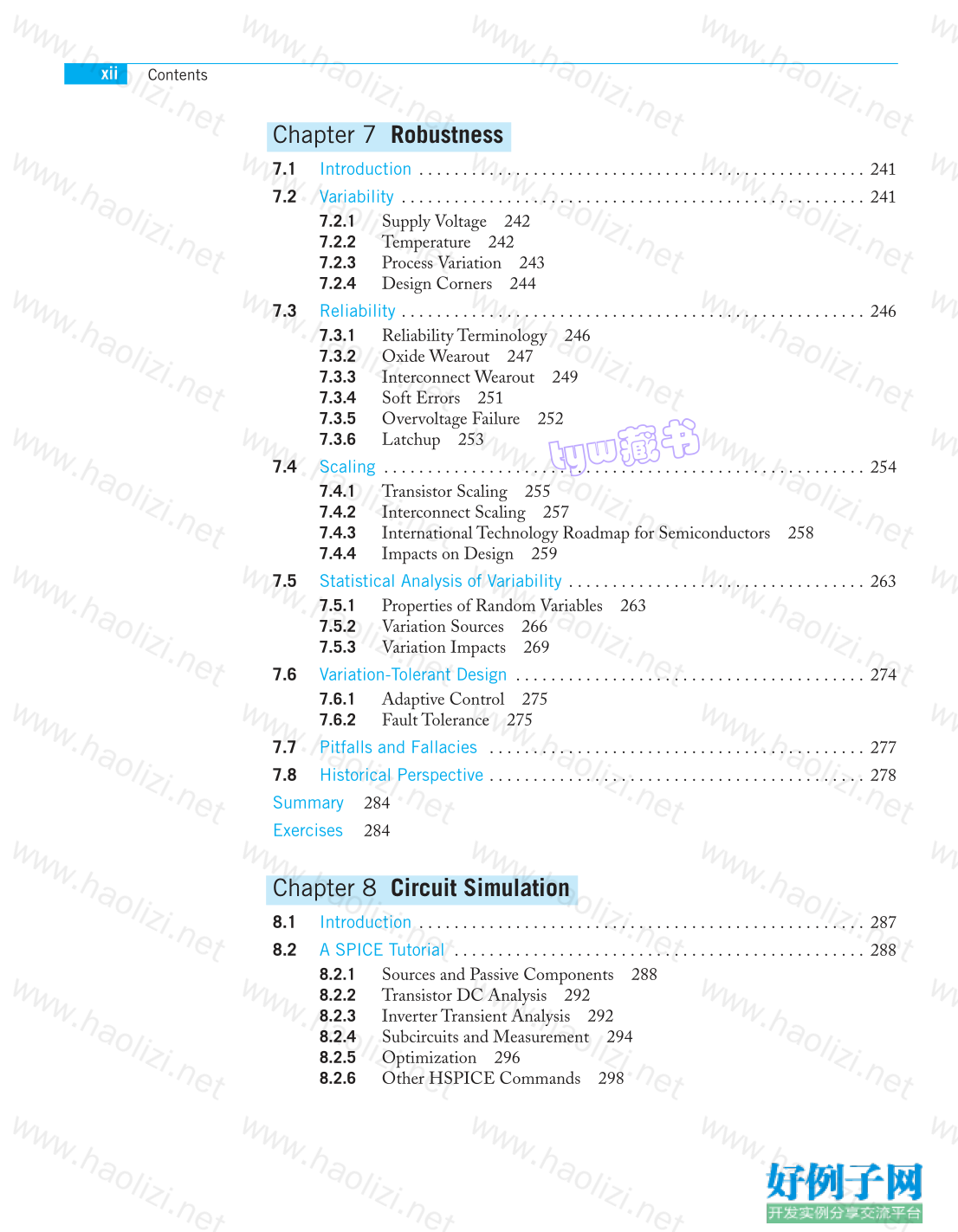
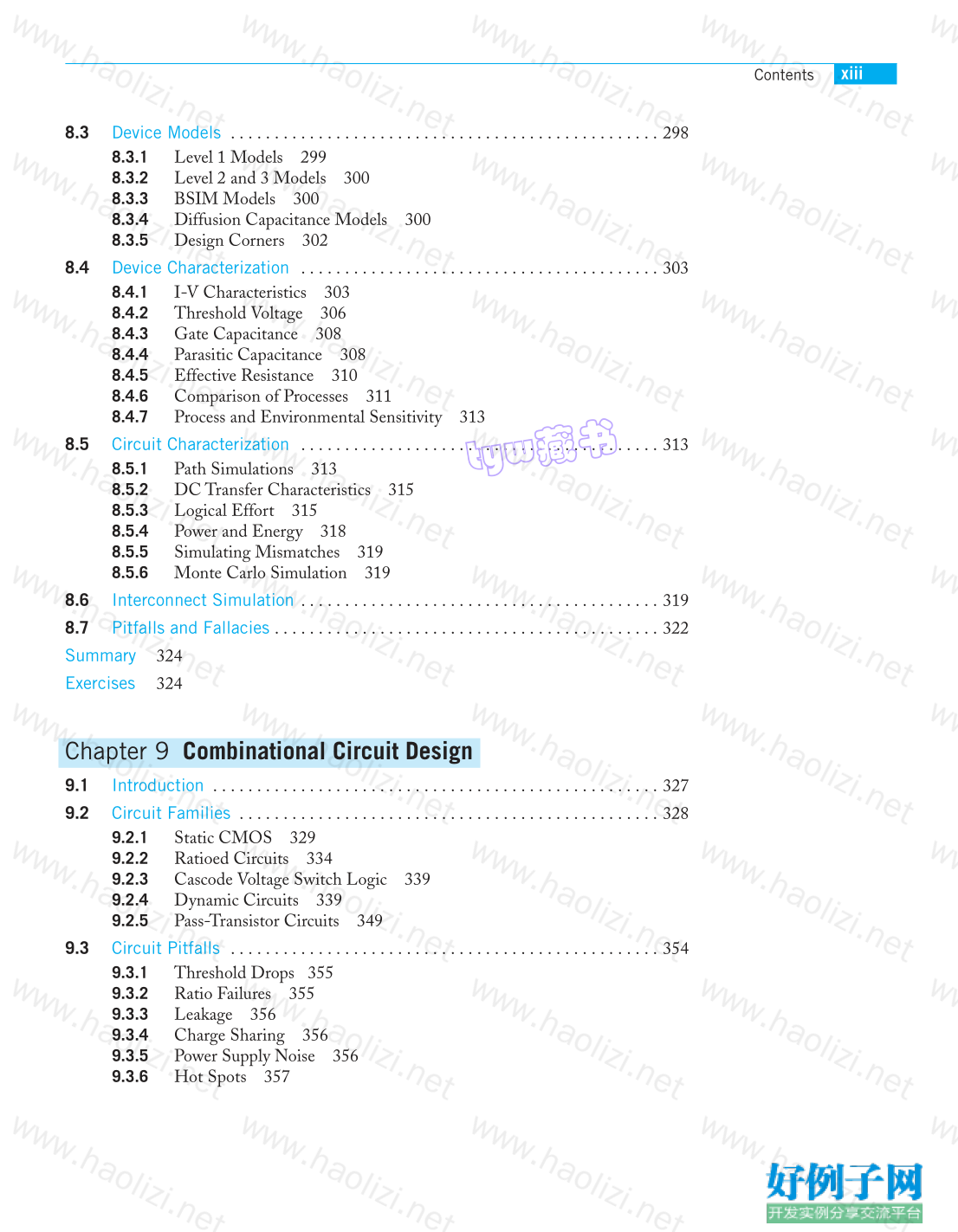
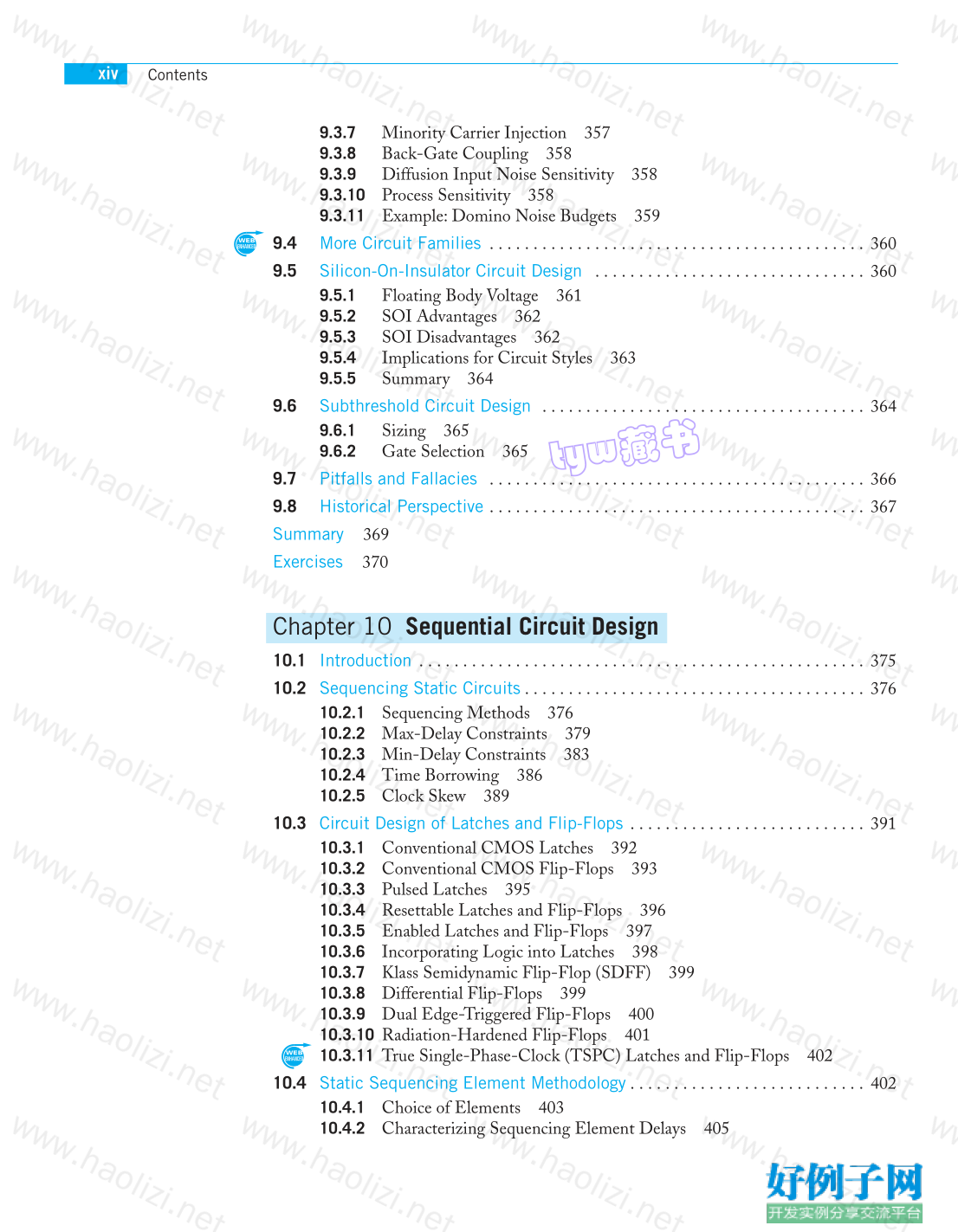
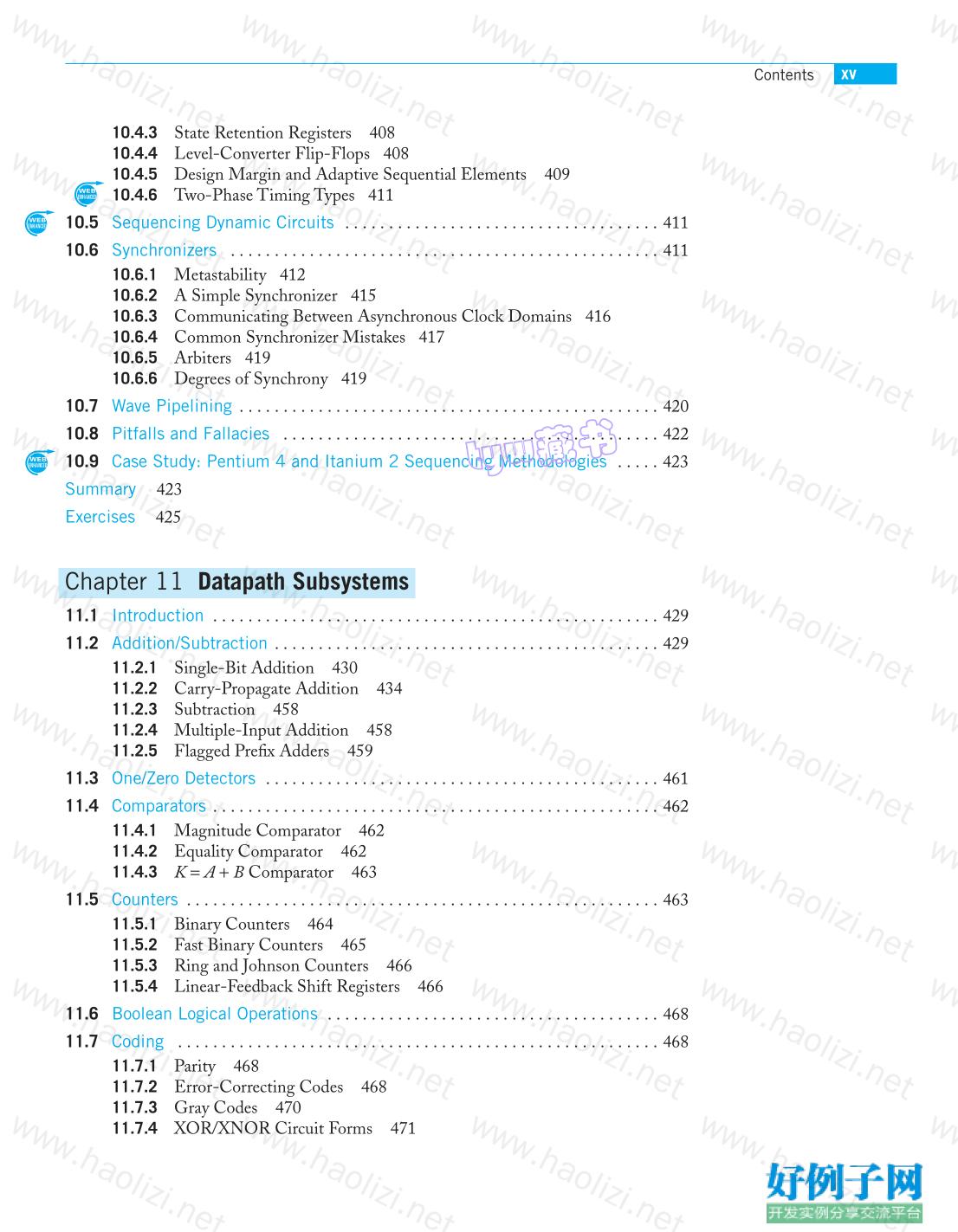

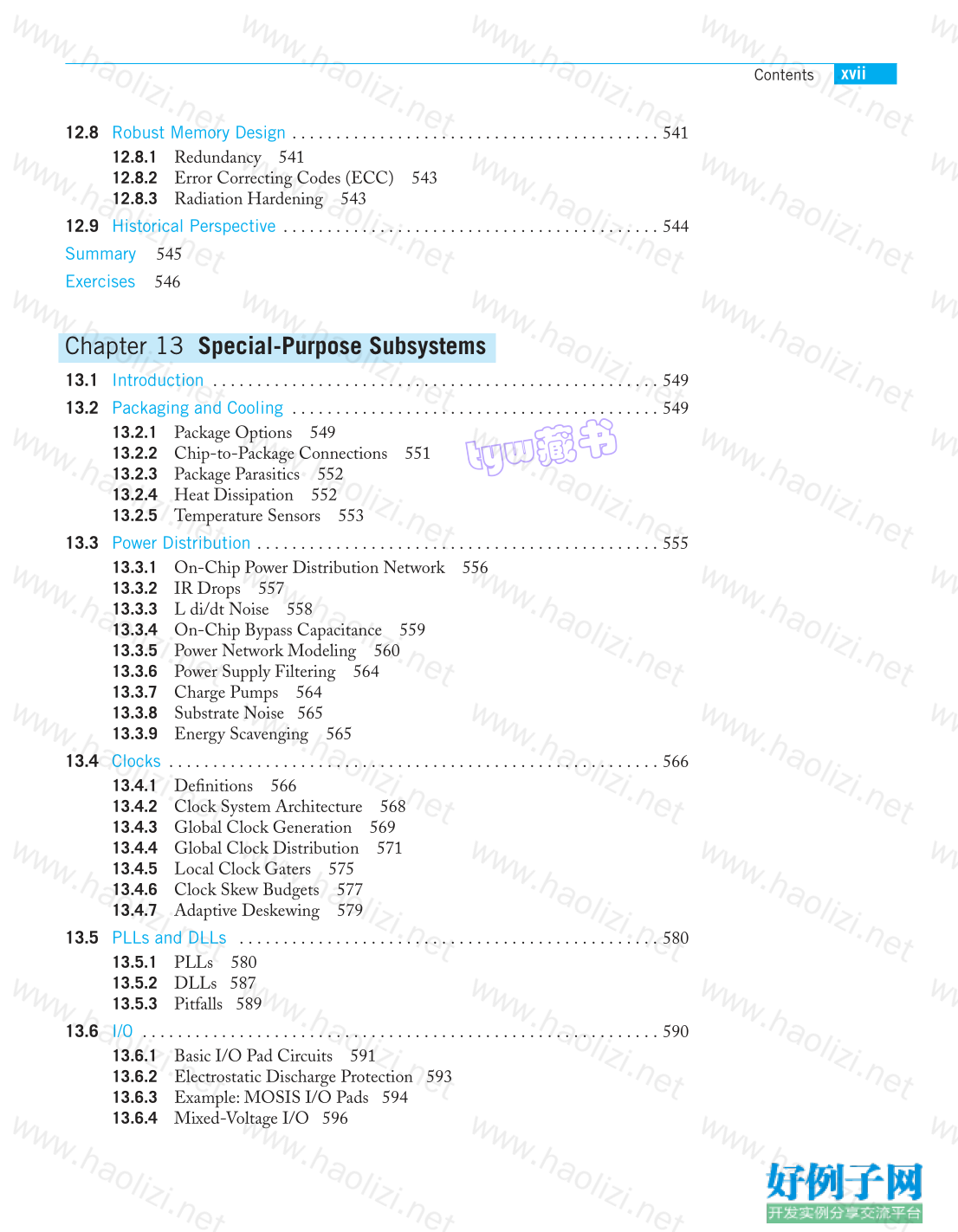

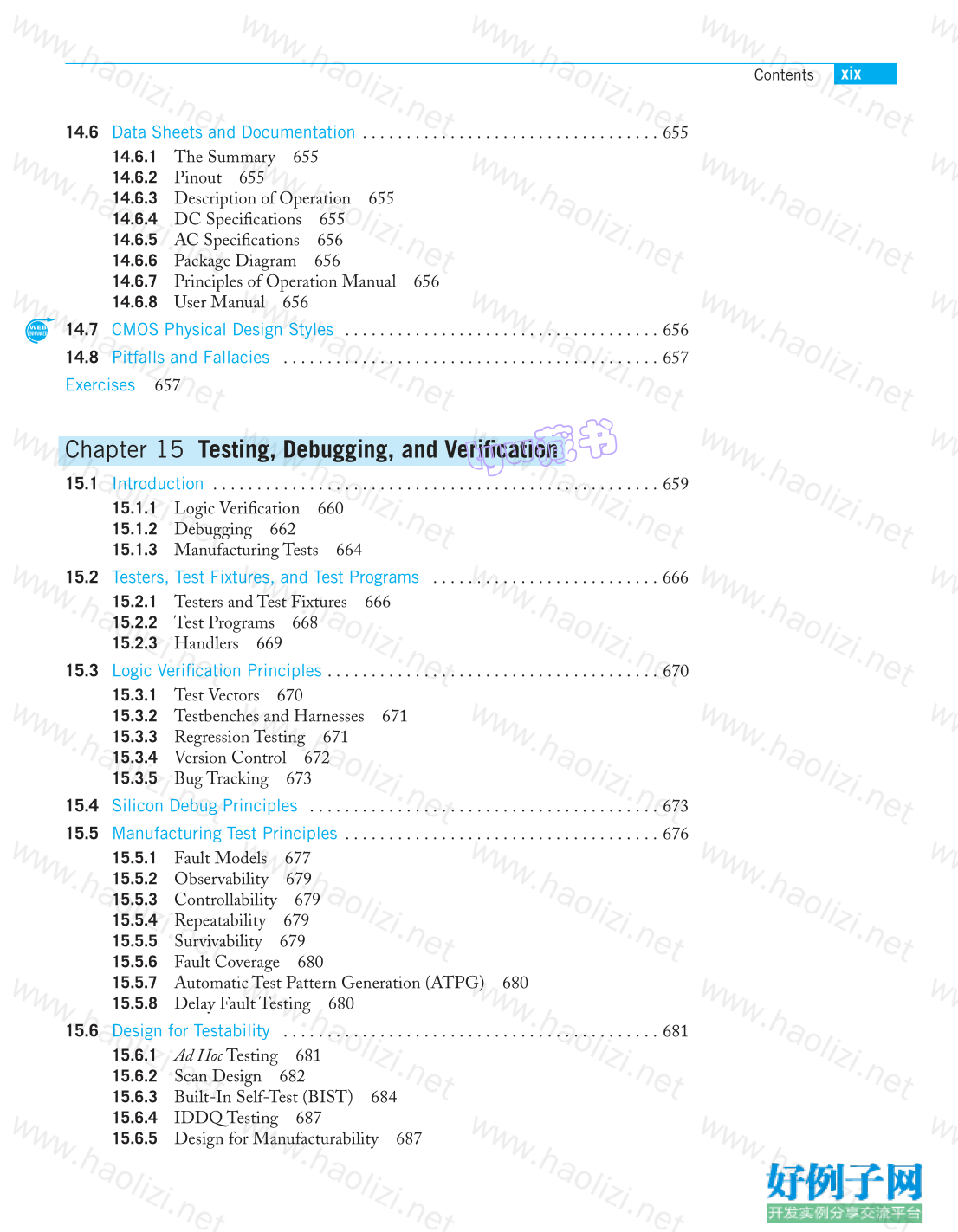
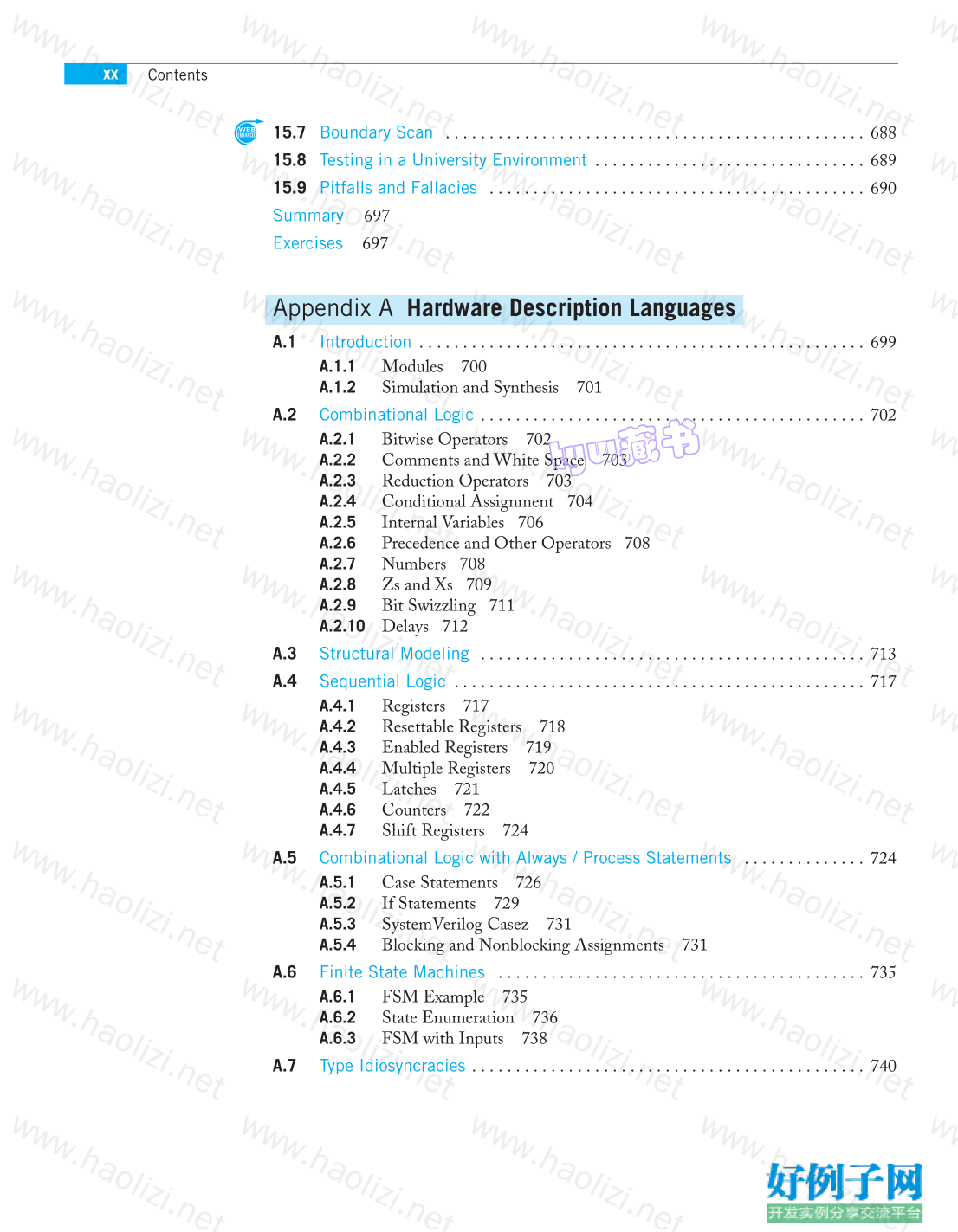
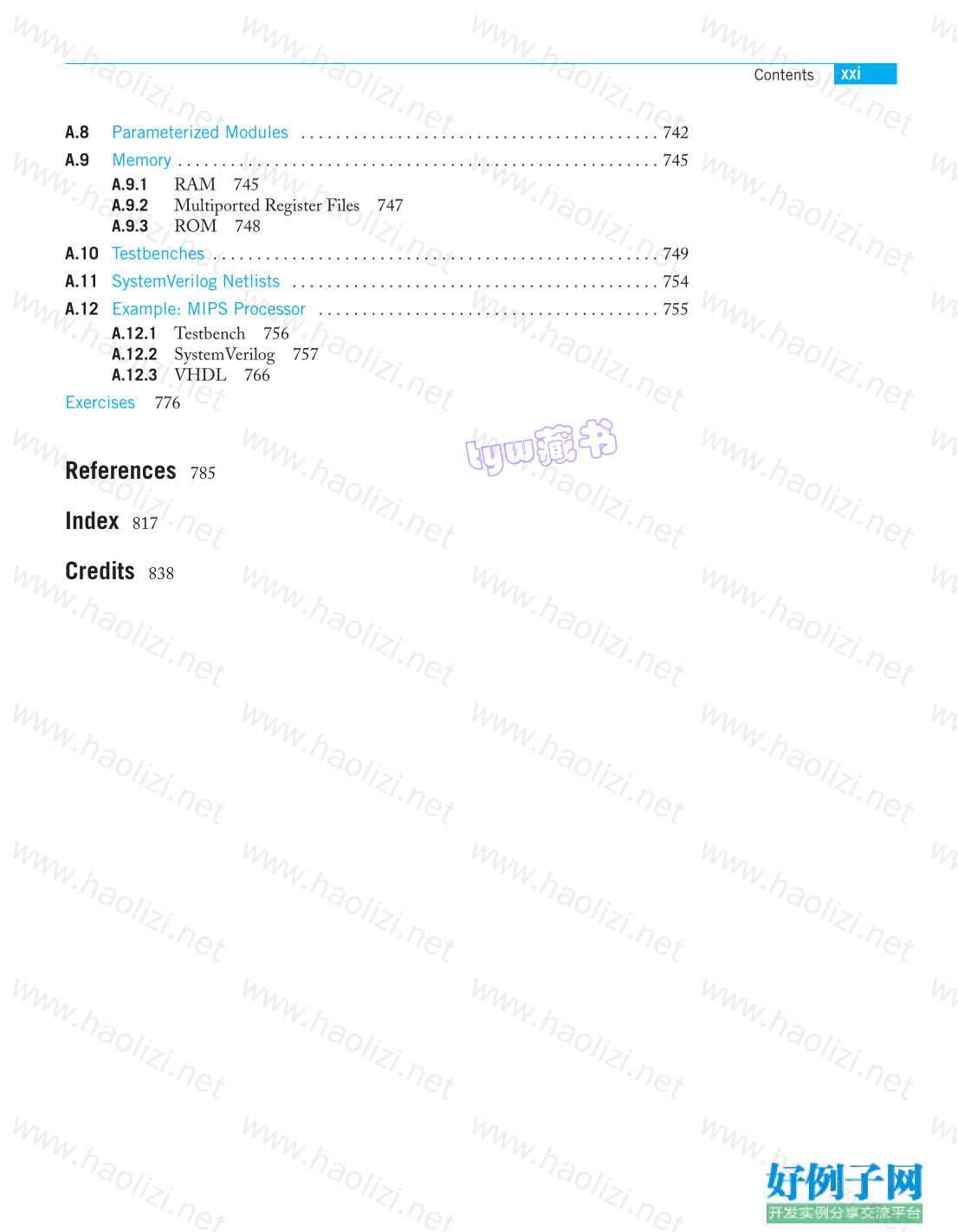
【核心代码】
Contents
tyw藏书
Contents viii
1.10 Physical Design . . . . . . . . . . . . . . . . . . . . . . . . . . . . . . . . . . . . . . . . . . . . . . . . . 45
1.10.1 Floorplanning 45
1.10.2 Standard Cells 48
1.10.3 Pitch Matching 50
1.10.4 Slice Plans 50
1.10.5 Arrays 51
1.10.6 Area Estimation 51
1.11 Design Verification . . . . . . . . . . . . . . . . . . . . . . . . . . . . . . . . . . . . . . . . . . . . . . 53
1.12 Fabrication, Packaging, and Testing . . . . . . . . . . . . . . . . . . . . . . . . . . . . . . . . 54
Summary and a Look Ahead 55
Exercises 57
Chapter 2 MOS Transistor Theory
2.1 Introduction . . . . . . . . . . . . . . . . . . . . . . . . . . . . . . . . . . . . . . . . . . . . . . . . . . . . 61
2.2 Long-Channel I-V Characteristics . . . . . . . . . . . . . . . . . . . . . . . . . . . . . . . . . . 64
2.3 C-V Characteristics . . . . . . . . . . . . . . . . . . . . . . . . . . . . . . . . . . . . . . . . . . . . . . 68
2.3.1 Simple MOS Capacitance Models 68
2.3.2 Detailed MOS Gate Capacitance Model 70
2.3.3 Detailed MOS Diffusion Capacitance Model 72
2.4 Nonideal I-V Effects . . . . . . . . . . . . . . . . . . . . . . . . . . . . . . . . . . . . . . . . . . . . . 74
2.4.1 Mobility Degradation and Velocity Saturation 75
2.4.2 Channel Length Modulation 78
2.4.3 Threshold Voltage Effects 79
2.4.4 Leakage 80
2.4.5 Temperature Dependence 85
2.4.6 Geometry Dependence 86
2.4.7 Summary 86
2.5 DC Transfer Characteristics . . . . . . . . . . . . . . . . . . . . . . . . . . . . . . . . . . . . . . . 87
2.5.1 Static CMOS Inverter DC Characteristics 88
2.5.2 Beta Ratio Effects 90
2.5.3 Noise Margin 91
2.5.4 Pass Transistor DC Characteristics 92
2.6 Pitfalls and Fallacies . . . . . . . . . . . . . . . . . . . . . . . . . . . . . . . . . . . . . . . . . . . . 93
Summary 94
Exercises 95
Chapter 3 CMOS Processing Technology
3.1 Introduction . . . . . . . . . . . . . . . . . . . . . . . . . . . . . . . . . . . . . . . . . . . . . . . . . . . . 99
3.2 CMOS Technologies . . . . . . . . . . . . . . . . . . . . . . . . . . . . . . . . . . . . . . . . . . . . 100
3.2.1 Wafer Formation 100
3.2.2 Photolithography 101
tyw藏书
Contents ix
3.2.3 Well and Channel Formation 103
3.2.4 Silicon Dioxide (SiO 2 ) 105
3.2.5 Isolation 106
3.2.6 Gate Oxide 107
3.2.7 Gate and Source/Drain Formations 108
3.2.8 Contacts and Metallization 110
3.2.9 Passivation 112
3.2.10 Metrology 112
3.3 Layout Design Rules . . . . . . . . . . . . . . . . . . . . . . . . . . . . . . . . . . . . . . . . . . . . 113
3.3.1 Design Rule Background 113
3.3.2 Scribe Line and Other Structures 116
3.3.3 MOSIS Scalable CMOS Design Rules 117
3.3.4 Micron Design Rules 118
3.4 CMOS Process Enhancements . . . . . . . . . . . . . . . . . . . . . . . . . . . . . . . . . . . . 119
3.4.1 Transistors 119
3.4.2 Interconnect 122
3.4.3 Circuit Elements 124
3.4.4 Beyond Conventional CMOS 129
3.5 Technology-Related CAD Issues . . . . . . . . . . . . . . . . . . . . . . . . . . . . . . . . . . . 130
3.5.1 Design Rule Checking (DRC) 131
3.5.2 Circuit Extraction 132
3.6 Manufacturing Issues . . . . . . . . . . . . . . . . . . . . . . . . . . . . . . . . . . . . . . . . . . . 133
3.6.1 Antenna Rules 133
3.6.2 Layer Density Rules 134
3.6.3 Resolution Enhancement Rules 134
3.6.4 Metal Slotting Rules 135
3.6.5 Yield Enhancement Guidelines 135
3.7 Pitfalls and Fallacies . . . . . . . . . . . . . . . . . . . . . . . . . . . . . . . . . . . . . . . . . . . 136
3.8 Historical Perspective . . . . . . . . . . . . . . . . . . . . . . . . . . . . . . . . . . . . . . . . . . . 137
Summary 139
Exercises 139
Chapter 4 Delay
4.1 Introduction . . . . . . . . . . . . . . . . . . . . . . . . . . . . . . . . . . . . . . . . . . . . . . . . . . 141
4.1.1 Definitions 141
4.1.2 Timing Optimization 142
4.2 Transient Response . . . . . . . . . . . . . . . . . . . . . . . . . . . . . . . . . . . . . . . . . . . . . 143
4.3 RC Delay Model . . . . . . . . . . . . . . . . . . . . . . . . . . . . . . . . . . . . . . . . . . . . . . . . 146
4.3.1 Effective Resistance 146
4.3.2 Gate and Diffusion Capacitance 147
4.3.3 Equivalent RC Circuits 147
4.3.4 Transient Response 148
4.3.5 Elmore Delay 150
tyw藏书
Contents x
4.3.6 Layout Dependence of Capacitance 153
4.3.7 Determining Effective Resistance 154
4.4 Linear Delay Model . . . . . . . . . . . . . . . . . . . . . . . . . . . . . . . . . . . . . . . . . . . . . 155
4.4.1 Logical Effort 156
4.4.2 Parasitic Delay 156
4.4.3 Delay in a Logic Gate 158
4.4.4 Drive 159
4.4.5 Extracting Logical Effort from Datasheets 159
4.4.6 Limitations to the Linear Delay Model 160
4.5 Logical Effort of Paths . . . . . . . . . . . . . . . . . . . . . . . . . . . . . . . . . . . . . . . . . . 163
4.5.1 Delay in Multistage Logic Networks 163
4.5.2 Choosing the Best Number of Stages 166
4.5.3 Example 168
4.5.4 Summary and Observations 169
4.5.5 Limitations of Logical Effort 171
4.5.6 Iterative Solutions for Sizing 171
4.6 Timing Analysis Delay Models . . . . . . . . . . . . . . . . . . . . . . . . . . . . . . . . . . . . 173
4.6.1 Slope-Based Linear Model 173
4.6.2 Nonlinear Delay Model 174
4.6.3 Current Source Model 174
4.7 Pitfalls and Fallacies . . . . . . . . . . . . . . . . . . . . . . . . . . . . . . . . . . . . . . . . . . . 174
4.8 Historical Perspective . . . . . . . . . . . . . . . . . . . . . . . . . . . . . . . . . . . . . . . . . . . 175
Summary 176
Exercises 176
Chapter 5 Power
5.1 Introduction . . . . . . . . . . . . . . . . . . . . . . . . . . . . . . . . . . . . . . . . . . . . . . . . . . . 181
5.1.1 Definitions 182
5.1.2 Examples 182
5.1.3 Sources of Power Dissipation 184
5.2 Dynamic Power . . . . . . . . . . . . . . . . . . . . . . . . . . . . . . . . . . . . . . . . . . . . . . . . 185
5.2.1 Activity Factor 186
5.2.2 Capacitance 188
5.2.3 Voltage 190
5.2.4 Frequency 192
5.2.5 Short-Circuit Current 193
5.2.6 Resonant Circuits 193
5.3 Static Power . . . . . . . . . . . . . . . . . . . . . . . . . . . . . . . . . . . . . . . . . . . . . . . . . . . 194
5.3.1 Static Power Sources 194
5.3.2 Power Gating 197
5.3.3 Multiple Threshold Voltages and Oxide Thicknesses 199
tyw藏书
Contents xi
5.3.4 Variable Threshold Voltages 199
5.3.5 Input Vector Control 200
5.4 Energy-Delay Optimization . . . . . . . . . . . . . . . . . . . . . . . . . . . . . . . . . . . . . . . 200
5.4.1 Minimum Energy 200
5.4.2 Minimum Energy-Delay Product 203
5.4.3 Minimum Energy Under a Delay Constraint 203
5.5 Low Power Architectures . . . . . . . . . . . . . . . . . . . . . . . . . . . . . . . . . . . . . . . . 204
5.5.1 Microarchitecture 204
5.5.2 Parallelism and Pipelining 204
5.5.3 Power Management Modes 205
5.6 Pitfalls and Fallacies . . . . . . . . . . . . . . . . . . . . . . . . . . . . . . . . . . . . . . . . . . . . 206
5.7 Historical Perspective . . . . . . . . . . . . . . . . . . . . . . . . . . . . . . . . . . . . . . . . . . . 207
Summary 209
Exercises 209
Chapter 6 Interconnect
6.1 Introduction . . . . . . . . . . . . . . . . . . . . . . . . . . . . . . . . . . . . . . . . . . . . . . . . . . . 211
6.1.1 Wire Geometry 211
6.1.2 Example: Intel Metal Stacks 212
6.2 Interconnect Modeling . . . . . . . . . . . . . . . . . . . . . . . . . . . . . . . . . . . . . . . . . . 213
6.2.1 Resistance 214
6.2.2 Capacitance 215
6.2.3 Inductance 218
6.2.4 Skin Effect 219
6.2.5 Temperature Dependence 220
6.3 Interconnect Impact . . . . . . . . . . . . . . . . . . . . . . . . . . . . . . . . . . . . . . . . . . . . 220
6.3.1 Delay 220
6.3.2 Energy 222
6.3.3 Crosstalk 222
6.3.4 Inductive Effects 224
6.3.5 An Aside on Effective Resistance and Elmore Delay 227
6.4 Interconnect Engineering . . . . . . . . . . . . . . . . . . . . . . . . . . . . . . . . . . . . . . . . 229
6.4.1 Width, Spacing, and Layer 229
6.4.2 Repeaters 230
6.4.3 Crosstalk Control 232
6.4.4 Low-Swing Signaling 234
6.4.5 Regenerators 236
6.5 Logical Effort with Wires . . . . . . . . . . . . . . . . . . . . . . . . . . . . . . . . . . . . . . . . 236
6.6 Pitfalls and Fallacies . . . . . . . . . . . . . . . . . . . . . . . . . . . . . . . . . . . . . . . . . . . . 237
Summary 238
Exercises 238
tyw藏书
Contents xii
Chapter 7 Robustness
7.1 Introduction . . . . . . . . . . . . . . . . . . . . . . . . . . . . . . . . . . . . . . . . . . . . . . . . . . . 241
7.2 Variability . . . . . . . . . . . . . . . . . . . . . . . . . . . . . . . . . . . . . . . . . . . . . . . . . . . . . 241
7.2.1 Supply Voltage 242
7.2.2 Temperature 242
7.2.3 Process Variation 243
7.2.4 Design Corners 244
7.3 Reliability . . . . . . . . . . . . . . . . . . . . . . . . . . . . . . . . . . . . . . . . . . . . . . . . . . . . . 246
7.3.1 Reliability Terminology 246
7.3.2 Oxide Wearout 247
7.3.3 Interconnect Wearout 249
7.3.4 Soft Errors 251
7.3.5 Overvoltage Failure 252
7.3.6 Latchup 253
7.4 Scaling . . . . . . . . . . . . . . . . . . . . . . . . . . . . . . . . . . . . . . . . . . . . . . . . . . . . . . . 254
7.4.1 Transistor Scaling 255
7.4.2 Interconnect Scaling 257
7.4.3 International Technology Roadmap for Semiconductors 258
7.4.4 Impacts on Design 259
7.5 Statistical Analysis of Variability . . . . . . . . . . . . . . . . . . . . . . . . . . . . . . . . . . 263
7.5.1 Properties of Random Variables 263
7.5.2 Variation Sources 266
7.5.3 Variation Impacts 269
7.6 Variation-Tolerant Design . . . . . . . . . . . . . . . . . . . . . . . . . . . . . . . . . . . . . . . . 274
7.6.1 Adaptive Control 275
7.6.2 Fault Tolerance 275
7.7 Pitfalls and Fallacies . . . . . . . . . . . . . . . . . . . . . . . . . . . . . . . . . . . . . . . . . . . 277
7.8 Historical Perspective . . . . . . . . . . . . . . . . . . . . . . . . . . . . . . . . . . . . . . . . . . . 278
Summary 284
Exercises 284
Chapter 8 Circuit Simulation
8.1 Introduction . . . . . . . . . . . . . . . . . . . . . . . . . . . . . . . . . . . . . . . . . . . . . . . . . . . 287
8.2 A SPICE Tutorial . . . . . . . . . . . . . . . . . . . . . . . . . . . . . . . . . . . . . . . . . . . . . . . 288
8.2.1 Sources and Passive Components 288
8.2.2 Transistor DC Analysis 292
8.2.3 Inverter Transient Analysis 292
8.2.4 Subcircuits and Measurement 294
8.2.5 Optimization 296
8.2.6 Other HSPICE Commands 298
tyw藏书
Contents xiii
8.3 Device Models . . . . . . . . . . . . . . . . . . . . . . . . . . . . . . . . . . . . . . . . . . . . . . . . . 298
8.3.1 Level 1 Models 299
8.3.2 Level 2 and 3 Models 300
8.3.3 BSIM Models 300
8.3.4 Diffusion Capacitance Models 300
8.3.5 Design Corners 302
8.4 Device Characterization . . . . . . . . . . . . . . . . . . . . . . . . . . . . . . . . . . . . . . . . . 303
8.4.1 I-V Characteristics 303
8.4.2 Threshold Voltage 306
8.4.3 Gate Capacitance 308
8.4.4 Parasitic Capacitance 308
8.4.5 Effective Resistance 310
8.4.6 Comparison of Processes 311
8.4.7 Process and Environmental Sensitivity 313
8.5 Circuit Characterization . . . . . . . . . . . . . . . . . . . . . . . . . . . . . . . . . . . . . . . . . 313
8.5.1 Path Simulations 313
8.5.2 DC Transfer Characteristics 315
8.5.3 Logical Effort 315
8.5.4 Power and Energy 318
8.5.5 Simulating Mismatches 319
8.5.6 Monte Carlo Simulation 319
8.6 Interconnect Simulation . . . . . . . . . . . . . . . . . . . . . . . . . . . . . . . . . . . . . . . . . 319
8.7 Pitfalls and Fallacies . . . . . . . . . . . . . . . . . . . . . . . . . . . . . . . . . . . . . . . . . . . . 322
Summary 324
Exercises 324
Chapter 9 Combinational Circuit Design
9.1 Introduction . . . . . . . . . . . . . . . . . . . . . . . . . . . . . . . . . . . . . . . . . . . . . . . . . . . 327
9.2 Circuit Families . . . . . . . . . . . . . . . . . . . . . . . . . . . . . . . . . . . . . . . . . . . . . . . . 328
9.2.1 Static CMOS 329
9.2.2 Ratioed Circuits 334
9.2.3 Cascode Voltage Switch Logic 339
9.2.4 Dynamic Circuits 339
9.2.5 Pass-Transistor Circuits 349
9.3 Circuit Pitfalls . . . . . . . . . . . . . . . . . . . . . . . . . . . . . . . . . . . . . . . . . . . . . . . . . 354
9.3.1 Threshold Drops 355
9.3.2 Ratio Failures 355
9.3.3 Leakage 356
9.3.4 Charge Sharing 356
9.3.5 Power Supply Noise 356
9.3.6 Hot Spots 357
tyw藏书
Contents xiv
9.3.7 Minority Carrier Injection 357
9.3.8 Back-Gate Coupling 358
9.3.9 Diffusion Input Noise Sensitivity 358
9.3.10 Process Sensitivity 358
9.3.11 Example: Domino Noise Budgets 359
9.4 More Circuit Families . . . . . . . . . . . . . . . . . . . . . . . . . . . . . . . . . . . . . . . . . . . 360
9.5 Silicon-On-Insulator Circuit Design . . . . . . . . . . . . . . . . . . . . . . . . . . . . . . . 360
9.5.1 Floating Body Voltage 361
9.5.2 SOI Advantages 362
9.5.3 SOI Disadvantages 362
9.5.4 Implications for Circuit Styles 363
9.5.5 Summary 364
9.6 Subthreshold Circuit Design . . . . . . . . . . . . . . . . . . . . . . . . . . . . . . . . . . . . . 364
9.6.1 Sizing 365
9.6.2 Gate Selection 365
9.7 Pitfalls and Fallacies . . . . . . . . . . . . . . . . . . . . . . . . . . . . . . . . . . . . . . . . . . . 366
9.8 Historical Perspective . . . . . . . . . . . . . . . . . . . . . . . . . . . . . . . . . . . . . . . . . . . 367
Summary 369
Exercises 370
Chapter 10 Sequential Circuit Design
10.1 Introduction . . . . . . . . . . . . . . . . . . . . . . . . . . . . . . . . . . . . . . . . . . . . . . . . . . . 375
10.2 Sequencing Static Circuits . . . . . . . . . . . . . . . . . . . . . . . . . . . . . . . . . . . . . . . 376
10.2.1 Sequencing Methods 376
10.2.2 Max-Delay Constraints 379
10.2.3 Min-Delay Constraints 383
10.2.4 Time Borrowing 386
10.2.5 Clock Skew 389
10.3 Circuit Design of Latches and Flip-Flops . . . . . . . . . . . . . . . . . . . . . . . . . . . 391
10.3.1 Conventional CMOS Latches 392
10.3.2 Conventional CMOS Flip-Flops 393
10.3.3 Pulsed Latches 395
10.3.4 Resettable Latches and Flip-Flops 396
10.3.5 Enabled Latches and Flip-Flops 397
10.3.6 Incorporating Logic into Latches 398
10.3.7 Klass Semidynamic Flip-Flop (SDFF) 399
10.3.8 Differential Flip-Flops 399
10.3.9 Dual Edge-Triggered Flip-Flops 400
10.3.10 Radiation-Hardened Flip-Flops 401
10.3.11 True Single-Phase-Clock (TSPC) Latches and Flip-Flops 402
10.4 Static Sequencing Element Methodology . . . . . . . . . . . . . . . . . . . . . . . . . . . 402
10.4.1 Choice of Elements 403
10.4.2 Characterizing Sequencing Element Delays 405
WEB
ENHANCED
WEB
ENHANCED
tyw藏书
Contents xv
10.4.3 State Retention Registers 408
10.4.4 Level-Converter Flip-Flops 408
10.4.5 Design Margin and Adaptive Sequential Elements 409
10.4.6 Two-Phase Timing Types 411
10.5 Sequencing Dynamic Circuits . . . . . . . . . . . . . . . . . . . . . . . . . . . . . . . . . . . . 411
10.6 Synchronizers . . . . . . . . . . . . . . . . . . . . . . . . . . . . . . . . . . . . . . . . . . . . . . . . . 411
10.6.1 Metastability 412
10.6.2 A Simple Synchronizer 415
10.6.3 Communicating Between Asynchronous Clock Domains 416
10.6.4 Common Synchronizer Mistakes 417
10.6.5 Arbiters 419
10.6.6 Degrees of Synchrony 419
10.7 Wave Pipelining . . . . . . . . . . . . . . . . . . . . . . . . . . . . . . . . . . . . . . . . . . . . . . . . 420
10.8 Pitfalls and Fallacies . . . . . . . . . . . . . . . . . . . . . . . . . . . . . . . . . . . . . . . . . . . 422
10.9 Case Study: Pentium 4 and Itanium 2 Sequencing Methodologies . . . . . 423
Summary 423
Exercises 425
Chapter 11 Datapath Subsystems
11.1 Introduction . . . . . . . . . . . . . . . . . . . . . . . . . . . . . . . . . . . . . . . . . . . . . . . . . . . 429
11.2 Addition/Subtraction . . . . . . . . . . . . . . . . . . . . . . . . . . . . . . . . . . . . . . . . . . . . 429
11.2.1 Single-Bit Addition 430
11.2.2 Carry-Propagate Addition 434
11.2.3 Subtraction 458
11.2.4 Multiple-Input Addition 458
11.2.5 Flagged Prefix Adders 459
11.3 One/Zero Detectors . . . . . . . . . . . . . . . . . . . . . . . . . . . . . . . . . . . . . . . . . . . . . 461
11.4 Comparators . . . . . . . . . . . . . . . . . . . . . . . . . . . . . . . . . . . . . . . . . . . . . . . . . . . 462
11.4.1 Magnitude Comparator 462
11.4.2 Equality Comparator 462
11.4.3 K = A B Comparator 463
11.5 Counters . . . . . . . . . . . . . . . . . . . . . . . . . . . . . . . . . . . . . . . . . . . . . . . . . . . . . . 463
11.5.1 Binary Counters 464
11.5.2 Fast Binary Counters 465
11.5.3 Ring and Johnson Counters 466
11.5.4 Linear-Feedback Shift Registers 466
11.6 Boolean Logical Operations . . . . . . . . . . . . . . . . . . . . . . . . . . . . . . . . . . . . . . 468
11.7 Coding . . . . . . . . . . . . . . . . . . . . . . . . . . . . . . . . . . . . . . . . . . . . . . . . . . . . . . . 468
11.7.1 Parity 468
11.7.2 Error-Correcting Codes 468
11.7.3 Gray Codes 470
11.7.4 XOR/XNOR Circuit Forms 471
WEB
ENHANCED
WEB
ENHANCED
WEB
ENHANCED
tyw藏书
Contents xvi
11.8 Shifters . . . . . . . . . . . . . . . . . . . . . . . . . . . . . . . . . . . . . . . . . . . . . . . . . . . . . . . 472
11.8.1 Funnel Shifter 473
11.8.2 Barrel Shifter 475
11.8.3 Alternative Shift Functions 476
11.9 Multiplication . . . . . . . . . . . . . . . . . . . . . . . . . . . . . . . . . . . . . . . . . . . . . . . . . 476
11.9.1 Unsigned Array Multiplication 478
11.9.2 Two’s Complement Array Multiplication 479
11.9.3 Booth Encoding 480
11.9.4 Column Addition 485
11.9.5 Final Addition 489
11.9.6 Fused Multiply-Add 490
11.9.7 Serial Multiplication 490
11.9.8 Summary 490
11.10 Parallel-Prefix Computations . . . . . . . . . . . . . . . . . . . . . . . . . . . . . . . . . . . . . 491
11.11Pitfalls and Fallacies . . . . . . . . . . . . . . . . . . . . . . . . . . . . . . . . . . . . . . . . . . . 493
Summary 494
Exercises 494
Chapter 12 Array Subsystems
12.1 Introduction . . . . . . . . . . . . . . . . . . . . . . . . . . . . . . . . . . . . . . . . . . . . . . . . . . . 497
12.2 SRAM . . . . . . . . . . . . . . . . . . . . . . . . . . . . . . . . . . . . . . . . . . . . . . . . . . . . . . . . 498
12.2.1 SRAM Cells 499
12.2.2 Row Circuitry 506
12.2.3 Column Circuitry 510
12.2.4 Multi-Ported SRAM and Register Files 514
12.2.5 Large SRAMs 515
12.2.6 Low-Power SRAMs 517
12.2.7 Area, Delay, and Power of RAMs and Register Files 520
12.3 DRAM . . . . . . . . . . . . . . . . . . . . . . . . . . . . . . . . . . . . . . . . . . . . . . . . . . . . . . . . 522
12.3.1 Subarray Architectures 523
12.3.2 Column Circuitry 525
12.3.3 Embedded DRAM 526
12.4 Read-Only Memory . . . . . . . . . . . . . . . . . . . . . . . . . . . . . . . . . . . . . . . . . . . . . 527
12.4.1 Programmable ROMs 529
12.4.2 NAND ROMs 530
12.4.3 Flash 531
12.5 Serial Access Memories . . . . . . . . . . . . . . . . . . . . . . . . . . . . . . . . . . . . . . . . . 533
12.5.1 Shift Registers 533
12.5.2 Queues (FIFO, LIFO) 533
12.6 Content-Addressable Memory . . . . . . . . . . . . . . . . . . . . . . . . . . . . . . . . . . . . 535
12.7 Programmable Logic Arrays . . . . . . . . . . . . . . . . . . . . . . . . . . . . . . . . . . . . . . 537
WEB
ENHANCED
tyw藏书
Contents xvii
12.8 Robust Memory Design . . . . . . . . . . . . . . . . . . . . . . . . . . . . . . . . . . . . . . . . . . 541
12.8.1 Redundancy 541
12.8.2 Error Correcting Codes (ECC) 543
12.8.3 Radiation Hardening 543
12.9 Historical Perspective . . . . . . . . . . . . . . . . . . . . . . . . . . . . . . . . . . . . . . . . . . . 544
Summary 545
Exercises 546
Chapter 13 Special-Purpose Subsystems
13.1 Introduction . . . . . . . . . . . . . . . . . . . . . . . . . . . . . . . . . . . . . . . . . . . . . . . . . . . 549
13.2 Packaging and Cooling . . . . . . . . . . . . . . . . . . . . . . . . . . . . . . . . . . . . . . . . . . 549
13.2.1 Package Options 549
13.2.2 Chip-to-Package Connections 551
13.2.3 Package Parasitics 552
13.2.4 Heat Dissipation 552
13.2.5 Temperature Sensors 553
13.3 Power Distribution . . . . . . . . . . . . . . . . . . . . . . . . . . . . . . . . . . . . . . . . . . . . . . 555
13.3.1 On-Chip Power Distribution Network 556
13.3.2 IR Drops 557
13.3.3 L di/dt Noise 558
13.3.4 On-Chip Bypass Capacitance 559
13.3.5 Power Network Modeling 560
13.3.6 Power Supply Filtering 564
13.3.7 Charge Pumps 564
13.3.8 Substrate Noise 565
13.3.9 Energy Scavenging 565
13.4 Clocks . . . . . . . . . . . . . . . . . . . . . . . . . . . . . . . . . . . . . . . . . . . . . . . . . . . . . . . . 566
13.4.1 Definitions 566
13.4.2 Clock System Architecture 568
13.4.3 Global Clock Generation 569
13.4.4 Global Clock Distribution 571
13.4.5 Local Clock Gaters 575
13.4.6 Clock Skew Budgets 577
13.4.7 Adaptive Deskewing 579
13.5 PLLs and DLLs . . . . . . . . . . . . . . . . . . . . . . . . . . . . . . . . . . . . . . . . . . . . . . . . 580
13.5.1 PLLs 580
13.5.2 DLLs 587
13.5.3 Pitfalls 589
13.6 I/0 . . . . . . . . . . . . . . . . . . . . . . . . . . . . . . . . . . . . . . . . . . . . . . . . . . . . . . . . . . . 590
13.6.1 Basic I/O Pad Circuits 591
13.6.2 Electrostatic Discharge Protection 593
13.6.3 Example: MOSIS I/O Pads 594
13.6.4 Mixed-Voltage I/O 596
tyw藏书
Contents xviii
13.7 High-Speed Links . . . . . . . . . . . . . . . . . . . . . . . . . . . . . . . . . . . . . . . . . . . . . . 597
13.7.1 High-Speed I/O Channels 597
13.7.2 Channel Noise and Interference 600
13.7.3 High-Speed Transmitters and Receivers 601
13.7.4 Synchronous Data Transmission 606
13.7.5 Clock Recovery in Source-Synchronous Systems 606
13.7.6 Clock Recovery in Mesochronous Systems 608
13.7.7 Clock Recovery in Pleisochronous Systems 610
13.8 Random Circuits . . . . . . . . . . . . . . . . . . . . . . . . . . . . . . . . . . . . . . . . . . . . . . . 610
13.8.1 True Random Number Generators 610
13.8.2 Chip Identification 611
13.9 Pitfalls and Fallacies . . . . . . . . . . . . . . . . . . . . . . . . . . . . . . . . . . . . . . . . . . . 612
Summary 613
Exercises 614
Chapter 14 Design Methodology and Tools
14.1 Introduction . . . . . . . . . . . . . . . . . . . . . . . . . . . . . . . . . . . . . . . . . . . . . . . . . . . 615
14.2 Structured Design Strategies . . . . . . . . . . . . . . . . . . . . . . . . . . . . . . . . . . . . . 617
14.2.1 A Software Radio—A System Example 618
14.2.2 Hierarchy 620
14.2.3 Regularity 623
14.2.4 Modularity 625
14.2.5 Locality 626
14.2.6 Summary 627
14.3 Design Methods . . . . . . . . . . . . . . . . . . . . . . . . . . . . . . . . . . . . . . . . . . . . . . . 627
14.3.1 Microprocessor/DSP 627
14.3.2 Programmable Logic 628
14.3.3 Gate Array and Sea of Gates Design 631
14.3.4 Cell-Based Design 632
14.3.5 Full Custom Design 634
14.3.6 Platform-Based Design—System on a Chip 635
14.3.7 Summary 636
14.4 Design Flows . . . . . . . . . . . . . . . . . . . . . . . . . . . . . . . . . . . . . . . . . . . . . . . . . . 636
14.4.1 Behavioral Synthesis Design Flow (ASIC Design Flow) 637
14.4.2 Automated Layout Generation 641
14.4.3 Mixed-Signal or Custom-Design Flow 645
14.5 Design Economics . . . . . . . . . . . . . . . . . . . . . . . . . . . . . . . . . . . . . . . . . . . . . . 646
14.5.1 Non-Recurring Engineering Costs (NREs) 647
14.5.2 Recurring Costs 649
14.5.3 Fixed Costs 650
14.5.4 Schedule 651
14.5.5 Personpower 653
14.5.6 Project Management 653
14.5.7 Design Reuse 654
tyw藏书
Contents xix
14.6 Data Sheets and Documentation . . . . . . . . . . . . . . . . . . . . . . . . . . . . . . . . . . 655
14.6.1 The Summary 655
14.6.2 Pinout 655
14.6.3 Description of Operation 655
14.6.4 DC Specifications 655
14.6.5 AC Specifications 656
14.6.6 Package Diagram 656
14.6.7 Principles of Operation Manual 656
14.6.8 User Manual 656
14.7 CMOS Physical Design Styles . . . . . . . . . . . . . . . . . . . . . . . . . . . . . . . . . . . . 656
14.8 Pitfalls and Fallacies . . . . . . . . . . . . . . . . . . . . . . . . . . . . . . . . . . . . . . . . . . . 657
Exercises 657
Chapter 15 Testing, Debugging, and Verification
15.1 Introduction . . . . . . . . . . . . . . . . . . . . . . . . . . . . . . . . . . . . . . . . . . . . . . . . . . . 659
15.1.1 Logic Verification 660
15.1.2 Debugging 662
15.1.3 Manufacturing Tests 664
15.2 Testers, Test Fixtures, and Test Programs . . . . . . . . . . . . . . . . . . . . . . . . . . 666
15.2.1 Testers and Test Fixtures 666
15.2.2 Test Programs 668
15.2.3 Handlers 669
15.3 Logic Verification Principles . . . . . . . . . . . . . . . . . . . . . . . . . . . . . . . . . . . . . . 670
15.3.1 Test Vectors 670
15.3.2 Testbenches and Harnesses 671
15.3.3 Regression Testing 671
15.3.4 Version Control 672
15.3.5 Bug Tracking 673
15.4 Silicon Debug Principles . . . . . . . . . . . . . . . . . . . . . . . . . . . . . . . . . . . . . . . . 673
15.5 Manufacturing Test Principles . . . . . . . . . . . . . . . . . . . . . . . . . . . . . . . . . . . . 676
15.5.1 Fault Models 677
15.5.2 Observability 679
15.5.3 Controllability 679
15.5.4 Repeatability 679
15.5.5 Survivability 679
15.5.6 Fault Coverage 680
15.5.7 Automatic Test Pattern Generation (ATPG) 680
15.5.8 Delay Fault Testing 680
15.6 Design for Testability . . . . . . . . . . . . . . . . . . . . . . . . . . . . . . . . . . . . . . . . . . . 681
15.6.1 Ad Hoc Testing 681
15.6.2 Scan Design 682
15.6.3 Built-In Self-Test (BIST) 684
15.6.4 IDDQ Testing 687
15.6.5 Design for Manufacturability 687
WEB
ENHANCED
tyw藏书
Contents xx
15.7 Boundary Scan . . . . . . . . . . . . . . . . . . . . . . . . . . . . . . . . . . . . . . . . . . . . . . . . 688
15.8 Testing in a University Environment . . . . . . . . . . . . . . . . . . . . . . . . . . . . . . . 689
15.9 Pitfalls and Fallacies . . . . . . . . . . . . . . . . . . . . . . . . . . . . . . . . . . . . . . . . . . . 690
Summary 697
Exercises 697
Appendix A Hardware Description Languages
A.1 Introduction . . . . . . . . . . . . . . . . . . . . . . . . . . . . . . . . . . . . . . . . . . . . . . . . . . . 699
A.1.1 Modules 700
A.1.2 Simulation and Synthesis 701
A.2 Combinational Logic . . . . . . . . . . . . . . . . . . . . . . . . . . . . . . . . . . . . . . . . . . . . 702
A.2.1 Bitwise Operators 702
A.2.2 Comments and White Space 703
A.2.3 Reduction Operators 703
A.2.4 Conditional Assignment 704
A.2.5 Internal Variables 706
A.2.6 Precedence and Other Operators 708
A.2.7 Numbers 708
A.2.8 Zs and Xs 709
A.2.9 Bit Swizzling 711
A.2.10 Delays 712
A.3 Structural Modeling . . . . . . . . . . . . . . . . . . . . . . . . . . . . . . . . . . . . . . . . . . . . 713
A.4 Sequential Logic . . . . . . . . . . . . . . . . . . . . . . . . . . . . . . . . . . . . . . . . . . . . . . . 717
A.4.1 Registers 717
A.4.2 Resettable Registers 718
A.4.3 Enabled Registers 719
A.4.4 Multiple Registers 720
A.4.5 Latches 721
A.4.6 Counters 722
A.4.7 Shift Registers 724
A.5 Combinational Logic with Always / Process Statements . . . . . . . . . . . . . . 724
A.5.1 Case Statements 726
A.5.2 If Statements 729
A.5.3 SystemVerilog Casez 731
A.5.4 Blocking and Nonblocking Assignments 731
A.6 Finite State Machines . . . . . . . . . . . . . . . . . . . . . . . . . . . . . . . . . . . . . . . . . . 735
A.6.1 FSM Example 735
A.6.2 State Enumeration 736
A.6.3 FSM with Inputs 738
A.7 Type Idiosyncracies . . . . . . . . . . . . . . . . . . . . . . . . . . . . . . . . . . . . . . . . . . . . . 740
WEB
ENHANCED
tyw藏书
Contents xxi
A.8 Parameterized Modules . . . . . . . . . . . . . . . . . . . . . . . . . . . . . . . . . . . . . . . . . 742
A.9 Memory . . . . . . . . . . . . . . . . . . . . . . . . . . . . . . . . . . . . . . . . . . . . . . . . . . . . . . . 745
A.9.1 RAM 745
A.9.2 Multiported Register Files 747
A.9.3 ROM 748
A.10 Testbenches . . . . . . . . . . . . . . . . . . . . . . . . . . . . . . . . . . . . . . . . . . . . . . . . . . . 749
A.11 SystemVerilog Netlists . . . . . . . . . . . . . . . . . . . . . . . . . . . . . . . . . . . . . . . . . . 754
A.12 Example: MIPS Processor . . . . . . . . . . . . . . . . . . . . . . . . . . . . . . . . . . . . . . . 755
A.12.1 Testbench 756
A.12.2 SystemVerilog 757
A.12.3 VHDL 766
Exercises 776
References 785
Index 817
Credits 838
2011 CMOS VLSI Design A Circuits and Systems Perspective-4th Edition.Neil.2011英文
小贴士
感谢您为本站写下的评论,您的评论对其它用户来说具有重要的参考价值,所以请认真填写。
- 类似“顶”、“沙发”之类没有营养的文字,对勤劳贡献的楼主来说是令人沮丧的反馈信息。
- 相信您也不想看到一排文字/表情墙,所以请不要反馈意义不大的重复字符,也请尽量不要纯表情的回复。
- 提问之前请再仔细看一遍楼主的说明,或许是您遗漏了。
- 请勿到处挖坑绊人、招贴广告。既占空间让人厌烦,又没人会搭理,于人于己都无利。
关于好例子网
本站旨在为广大IT学习爱好者提供一个非营利性互相学习交流分享平台。本站所有资源都可以被免费获取学习研究。本站资源来自网友分享,对搜索内容的合法性不具有预见性、识别性、控制性,仅供学习研究,请务必在下载后24小时内给予删除,不得用于其他任何用途,否则后果自负。基于互联网的特殊性,平台无法对用户传输的作品、信息、内容的权属或合法性、安全性、合规性、真实性、科学性、完整权、有效性等进行实质审查;无论平台是否已进行审查,用户均应自行承担因其传输的作品、信息、内容而可能或已经产生的侵权或权属纠纷等法律责任。本站所有资源不代表本站的观点或立场,基于网友分享,根据中国法律《信息网络传播权保护条例》第二十二与二十三条之规定,若资源存在侵权或相关问题请联系本站客服人员,点此联系我们。关于更多版权及免责申明参见 版权及免责申明



网友评论
我要评论